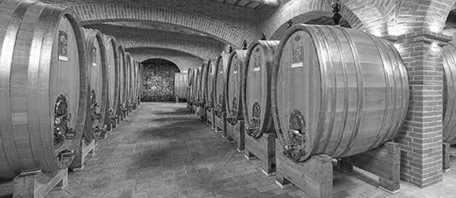
Which site would you like to visit?
By clicking the retail or wholesale site button and/or using rarewineco.com you are choosing to accept our use of cookies to provide you the best possible web experience.

Increasingly, food and wine lovers flock to Barolo and Barbaresco in the fall, to eat fresh white truffles on the region's glorious handmade egg pasta, along with the region's magical wines.
If you're among those lucky enough to visit this year, and to taste the wonderful 2019 Barolos, you may find white truffles both scarce and expensive, due to the region's ongoing drought. We were there the first week of November, and they were already very late coming into the market.
Hopefully, autumn rains will spur their development, making a visit to the Langhe this year all the more rewarding. And when you return home, you’ll undoubtedly want to recreate the magic of eating and drinking in the Langhe.
For nearly a quarter century, The Rare Wine Co. has offered its clients the next best thing to being in the Langhe … or to having direct access to fresh, high-quality white truffles at home.
Since the late 1990s, we've used our contacts in Alba’s wine and food community to secure not only the finest handmade pasta available, but also creams, oil and butters made from each year's local truffle harvest.
And over the years, Inaudi has become our go-to source for both superb, locally sourced truffle products and the finest egg tagliolini that we (and many of our clients) have ever tasted outside Italy.
Six Stellar Products
Inaudi's egg tagliolini (or tajarin in local dialect) surely ranks among the finest pasta on earth. Finely cut to 1/16", and containing six deep yellow Piemontese egg yolks per kilo of flour, we like it best cooked for exactly 3 minutes. When done right, the texture is eerily close to what you'll eat in Piemonte. It is available in your choice of twelve 8.8 oz. boxes or sixteen 8.8 oz. bags, all for the same price. If it's for yourself, get the bags!
For preserved truffle products, Inaudi is Piemonte's gold standard as well. In our opinion, their crowning achievements are their three truffle creams. Each is made from a different variety of Alba truffle and is produced by finely grinding truffles into an olive oil base. And, each jar contains a generous 72% of the named truffle.
We also love Inaudi's incredibly versatile truffle butter, a blend of creamery butter with 7% summer black and/or bianchetti truffles. Finally, Inaudi's white truffle oil is the finest of the genre, avoiding the chemical aromas of many truffle oils.
Free Shipping on Pasta!
And when you buy a case of pasta,
all truffle products ship free, too!
| Year | Description | Size | Notes | Avail/ Limit |
Price | |
|---|---|---|---|---|---|---|

|
Inaudi Tagliolini All'Uovo [Egg Pasta] No Box 16 CT. Case 250G | 250G | 4 | $125.00 | add | |

|
Inaudi Tagliolini All'Uovo [Egg Pasta] Boxed, 12CT 250G | 250G | 4 | $125.00 | add |
| Year | Description | Size | Notes | Avail/ Limit |
Price | |
|---|---|---|---|---|---|---|

|
Inaudi Truffle Butter, 580G | 3 | $58.50 | add | ||

|
Inaudi Black Truffle Cream [Tuber Aestivum] 30G | 1 | $27.50 | add |
New discoveries, rare bottles of extraordinary provenance, limited time offers delivered to your inbox weekly. Be the first to know.
Please Wait
Adding to Cart.
...Loading...


By clicking the retail or wholesale site button and/or using rarewineco.com you are choosing to accept our use of cookies to provide you the best possible web experience.

